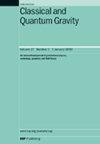Adjustable picometer-stable interferometers for testing space-based gravitational wave detectors
IF 3.7
3区 物理与天体物理
Q2 ASTRONOMY & ASTROPHYSICS
引用次数: 0
Abstract
Space-based gravitational wave detectors, such as the Laser Interferometer Space Antenna, use picometer-precision laser interferometry to detect gravitational waves at frequencies from 1 Hz down to below 0.1 mHz. Laser interferometers used for on-ground prototyping and testing of such instruments are typically constructed by permanently bonding or gluing optics onto an ultra-stable bench made of low-expansion glass ceramic. This design minimises temperature coupling to length and tilt, which dominates the noise at low frequencies due to finite temperature stability achievable in laboratories and vacuum environments. Here, we present the study of an alternative opto-mechanical concept where optical components are placed with adjustable and freely positionable mounts on an ultra-stable bench, while maintaining picometer length stability. With this concept, a given interferometer configuration can be realised very quickly due to a simplified and speed-up assembly process, reducing the realisation time from weeks or months to a matter of hours. We built a corresponding test facility and verified the length stability of our concept by measuring the length change in an optical cavity that was probed with two different locking schemes, heterodyne laser frequency stabilisation and Pound–Drever–Hall locking. We studied the limitations of both locking schemes and verified that the cavity length noise is below 1 pm for frequencies down to 3 mHz. We thereby demonstrate that our concept can simplify the testing of interferometer configurations and opto-mechanical components and is suitable to realise flexible optical ground support equipment for space missions that use laser interferometry, such as future space-based gravitational wave detectors and satellite geodesy missions.用于测试天基引力波探测器的可调皮米稳定干涉仪
天基引力波探测器,如激光干涉仪空间天线,使用皮米精度的激光干涉测量技术来探测频率从1hz到0.1 mHz以下的引力波。用于此类仪器的地面原型和测试的激光干涉仪通常是通过将光学器件永久粘合或粘合到由低膨胀玻璃陶瓷制成的超稳定工作台上而构建的。这种设计最大限度地减少了长度和倾斜的温度耦合,由于在实验室和真空环境中可以实现有限的温度稳定性,因此在低频下占主导地位。在这里,我们提出了一种替代光机械概念的研究,其中光学元件放置在超稳定的工作台上,可调节和自由定位,同时保持皮米长度稳定性。有了这个概念,由于简化和加速的装配过程,给定的干涉仪配置可以非常快速地实现,将实现时间从几周或几个月减少到几个小时。我们建立了一个相应的测试设施,并通过测量光学腔的长度变化来验证我们的概念的长度稳定性,该光学腔采用两种不同的锁定方案,外差激光频率稳定和庞德-德雷弗-霍尔锁定。我们研究了这两种锁定方案的局限性,并验证了在低至3mhz的频率下,腔长噪声低于1 pm。因此,我们证明了我们的概念可以简化干涉仪配置和光机械组件的测试,并且适用于实现使用激光干涉测量的空间任务的柔性光学地面支持设备,例如未来的天基引力波探测器和卫星大地测量任务。
本文章由计算机程序翻译,如有差异,请以英文原文为准。
求助全文
约1分钟内获得全文
求助全文
来源期刊

Classical and Quantum Gravity
物理-天文与天体物理
CiteScore
7.00
自引率
8.60%
发文量
301
审稿时长
2-4 weeks
期刊介绍:
Classical and Quantum Gravity is an established journal for physicists, mathematicians and cosmologists in the fields of gravitation and the theory of spacetime. The journal is now the acknowledged world leader in classical relativity and all areas of quantum gravity.
 求助内容:
求助内容: 应助结果提醒方式:
应助结果提醒方式:


